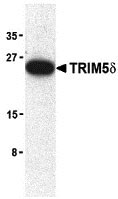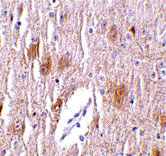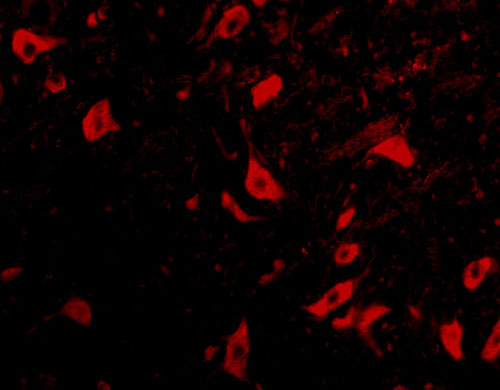TRIM5 delta Antibody
- 产品详情
- 实验流程
- 背景知识
Application
| WB, IF, E, IHC-P |
|---|---|
| Primary Accession | Q9C035 |
| Other Accession | NP_149084, 15011946 |
| Reactivity | Human |
| Host | Rabbit |
| Clonality | Polyclonal |
| Isotype | IgG |
| Calculated MW | 56338 Da |
| Concentration (mg/ml) | 1 mg/mL |
| Conjugate | Unconjugated |
| Application Notes | TRIM5 delta antibody can be used for detection of TRIM5 delta by Western blot at 2 µg/mL. A band at approximately 25 kDa can be detected. Antibody can also be used for immunohistochemistry starting at 1 µg/mL. For immunofluorescence start at 10 µg/mL. |
| Gene ID | 85363 |
|---|---|
| Other Names | TRIM5 delta Antibody: RNF88, TRIM5alpha, RNF88, Tripartite motif-containing protein 5, RING finger protein 88, tripartite motif-containing 5 |
| Target/Specificity | TRIM5; |
| Reconstitution & Storage | TRIM5 delta antibody can be stored at 4℃ for three months and -20℃, stable for up to one year. As with all antibodies care should be taken to avoid repeated freeze thaw cycles. Antibodies should not be exposed to prolonged high temperatures. |
| Precautions | TRIM5 delta Antibody is for research use only and not for use in diagnostic or therapeutic procedures. |
| Name | TRIM5 |
|---|---|
| Synonyms | RNF88 |
| Function | Capsid-specific restriction factor that prevents infection from non-host-adapted retroviruses. Blocks viral replication early in the life cycle, after viral entry but before reverse transcription. In addition to acting as a capsid-specific restriction factor, also acts as a pattern recognition receptor that activates innate immune signaling in response to the retroviral capsid lattice. Binding to the viral capsid triggers its E3 ubiquitin ligase activity, and in concert with the heterodimeric ubiquitin conjugating enzyme complex UBE2V1- UBE2N (also known as UBC13-UEV1A complex) generates 'Lys-63'-linked polyubiquitin chains, which in turn are catalysts in the autophosphorylation of the MAP3K7/TAK1 complex (includes TAK1, TAB2, and TAB3). Activation of the MAP3K7/TAK1 complex by autophosphorylation results in the induction and expression of NF-kappa-B and MAPK- responsive inflammatory genes, thereby leading to an innate immune response in the infected cell. Restricts infection by N-tropic murine leukemia virus (N-MLV), equine infectious anemia virus (EIAV), simian immunodeficiency virus of macaques (SIVmac), feline immunodeficiency virus (FIV), and bovine immunodeficiency virus (BIV) (PubMed:17156811). Plays a role in regulating autophagy through activation of autophagy regulator BECN1 by causing its dissociation from its inhibitors BCL2 and TAB2 (PubMed:25127057). Also plays a role in autophagy by acting as a selective autophagy receptor which recognizes and targets HIV-1 capsid protein p24 for autophagic destruction (PubMed:25127057). |
| Cellular Location | Cytoplasm. Nucleus {ECO:0000250|UniProtKB:Q0PF16}. Note=Predominantly localizes in cytoplasmic bodies (PubMed:12878161, PubMed:20357094). Localization may be influenced by the coexpression of other TRIM proteins, hence partial nuclear localization is observed in the presence of TRIM22 or TRIM27 (By similarity). In cytoplasmic bodies, colocalizes with proteasomal subunits and SQSTM1 (By similarity). {ECO:0000250|UniProtKB:Q0PF16, ECO:0000269|PubMed:12878161, ECO:0000269|PubMed:20357094, ECO:0000269|PubMed:25127057} |
For Research Use Only. Not For Use In Diagnostic Procedures.
Provided below are standard protocols that you may find useful for product applications.
BACKGROUND
TRIM5 delta Antibody: TRIM5 is a member of a broad family of otherwise unrelated proteins defined by the presence of a tripartite motif containing a RING domain, a B-box type 1, and a B-box type 2, followed by a coiled-coil region. TRIM5 has five alternately spliced isoforms, the longest of which is the alpha variant which also contains a carboxy-terminal B30.2 (SPRY) domain. Expression of TRIM5α variants from humans, rhesus monkeys, and African green monkeys enabled resistance to infection by various retroviruses including HIV-1, albeit at differing efficiencies. The TRIM5δ isoform has been shown to colocalize with the topoisomerase I-interacting proteins BTBD1 and BTBD2 in punctate or elongated cytoplasmic bodies in several mouse and human cells where it appears to serve as a scaffold for the assembly of endogenous BTBD proteins. TRIM5δ also exhibits autoubiquitination activity in a RING finger- and UbcH5B-dependent manner.
REFERENCES
Reymond A, Meroni G, Fantozzi A, et al. The tripartite motif family identifies cell compartments. EMBO J. 2001; 20:2140-51.
Stremlau M, Owens CM, Perron MJ, et al. The cytoplasmic body component TRIM5a restricts HIV-1 infection in Old World monkeys. Nature 2004; 427:848-53.
Hatziioannou T, Perez-Caballero D, Yang A, et al. Retrovirus resistance factors REF1 and Lv1 are species-specific variants of TRIM5α. Proc. Nat’l. Acad. Sci. USA 2004; 101:10774-9
Xu L, Yang L, Moitra PK, et al. BTBD1 and BTBD2 colocalize to cytoplasmic bodies with the RBCC/tripartite motif protein, TRIM5a. Exp. Cell Res. 2003; 288:84-93.
终于等到您。ABCEPTA(百远生物)抗体产品。
点击下方“我要评价 ”按钮提交您的反馈信息,您的反馈和评价是我们最宝贵的财富之一,
我们将在1-3个工作日内处理您的反馈信息。
如有疑问,联系:0512-88856768 tech-china@abcepta.com.























 癌症的基本特征包括细胞增殖、血管生成、迁移、凋亡逃避机制和细胞永生等。找到癌症发生过程中这些通路的关键标记物和对应的抗体用于检测至关重要。
癌症的基本特征包括细胞增殖、血管生成、迁移、凋亡逃避机制和细胞永生等。找到癌症发生过程中这些通路的关键标记物和对应的抗体用于检测至关重要。 为您推荐一个泛素化位点预测神器——泛素化分析工具,可以为您的蛋白的泛素化位点作出预测和评分。
为您推荐一个泛素化位点预测神器——泛素化分析工具,可以为您的蛋白的泛素化位点作出预测和评分。 细胞自噬受体图形绘图工具为你的蛋白的细胞受体结合位点作出预测和评分,识别结合到自噬通路中的蛋白是非常重要的,便于让我们理解自噬在正常生理、病理过程中的作用,如发育、细胞分化、神经退化性疾病、压力条件下、感染和癌症。
细胞自噬受体图形绘图工具为你的蛋白的细胞受体结合位点作出预测和评分,识别结合到自噬通路中的蛋白是非常重要的,便于让我们理解自噬在正常生理、病理过程中的作用,如发育、细胞分化、神经退化性疾病、压力条件下、感染和癌症。








